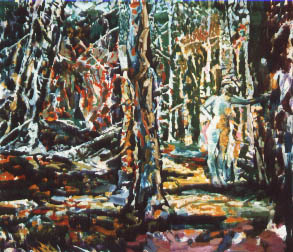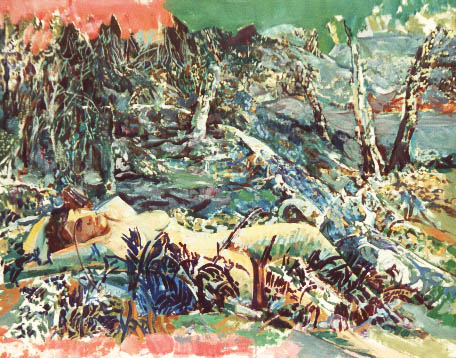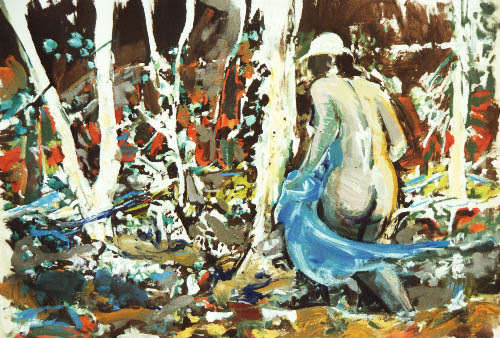To help you understand my figurative paintings, I am pleased to present the
following article written by Art Historian, Marie Leduc of Malaspina College in
Nanaimo B.C. Canada. The article appears in the Summer 1997 issue of Artichoke.
Many of the images shown here were exhibited at my one-man show of paintings at
the Nanaimo Art Gallery, August 2 to September 8, 1996.
"In Jessop's painting, the landscape is combined with the female
figure to form images rich in signification. Jessop's series of 5 x 6 foot and
3 x 4 foot canvases invite us into a pastoral world of forests and streams
inhabited by a lone female bather. The figure, an anonymous nude, holds equal
space and presence with the landscape that surrounds her. Water, leaves, and
trees flicker with quick, bold brushstrokes, and the figure, shaped by the
same signature strokes, reflects the blues, browns, oranges, and greens of the
forest that encloses her.
Jessop,s larger paintings are bright and light, representing the poplar
forests of Alberta and Saskatchewan. Cool blues and greens create shaded
arbors, while brown washes and sparks of yellow add warmth. The scenes are lit
in brilliant sunlight that filters through the thin cover of leaves.
Technically, the light comes from the white underpainting that Jessop does not
hesitate to leave bare and visible. Like a watercolourist, he allows the white
canvas to shine through layers of thin washes and fleeting brushwork. Barely
touching down on the canvas, the more opaque brushstrokes create a movement
which, like a memory, is rich but only transitory.
These are contented images, of sun and shade on a warm day beside a cooling
stream. The presence of a nude female in the scenes immediately suggests the
arcadian subject of the bather. Jessop's representation of this theme,
however, does not have the classical magnitude of a Corot. or the coquettish
eroticism of a Renoir. Jessop's woman is anonymous; her image sketched as
rapidly and indefinably as the the trees, leaves, and stream. She is relaxed
and at home in these forests of sun and shade. Sometimes she wears a hat or
sun glasses; objects which transport us out of the arcadian dream and into our
own time. She is, perhaps, most like a Courbet's ample and ordinary country
women in 'Les Baigneuses" who, with obvious ease, carry on with their
bathing in a familiar surrounding. Unlike Courbet, however, Jessop seems to
avoid the sense of voyeurism that typically pervades the bather genre. Rather,
his paintings suggest a privacy and a solitariness that should be left
respectfully undisturbed. In "The Wait"(1993), the woman sits deep
in thought. Her hands rest in her lap and her feet are in the stream as she
looks into the woods before her. Her nudity is insignificant and does not seem
to elicit unwanted attention. In fact, it is so inconsequential the she seems
clothed in a moment of reverie.
Jessop's pictures are not only paintings of land and figure, but images
that make us question how we see. The fleeting, broken, almost abstract method
of painting that Jessop employs recalls the visual experimentations of the
Impressionists. Colour and light exist out of necessity for each other, yet
only temporarily. At the same time, Jessop's active surfaces and large
canvases suggest the Abstract Expressionists, and to some degree Willem de
Kooning's quickly stroked images. Jessop studied for his MFA at the University
of Regina in the 1970's and readily admits to Modernist influences. The Regina
Five, as well as the watercolour landscapes of Dorothy Knowles, have played a
significant role in his painting style.
Regina Five painters Arthur McKay and Ronald Bloore have a specific
influence in Jessop's series of very large mandala paintings. Presented
alongside the figurative landscapes, the five- and six- foot diameter mandalas
take the vision of the land to an abstract conclusion. Each mandala is based
on the female image, the colours of the landscape, and the brushstroke
patterns of one of his representational works. Recomposed into concentric
circles set on a solid square base, the original elements create a totally new
image. Cool, calm colours in one ring are countered by the lively calligraphic
energy of the brushstrokes in another. Like a pulsating, living emblem of
life, the mandalas seem to symbolize Jessop's studies of light and colour,
land and figure, churned and recreated into a visual 'primal soup'. Juxtaposed
with their more representational originals, these mandala paintings leave us
pondering the origins of life, nature, and our very transitory existence in
the world."










